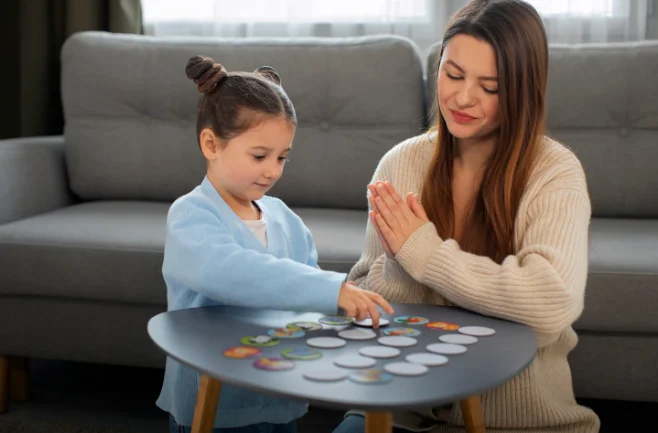Many parents feel lost trying to find the right tools for their child with Autism Spectrum Disorder. It’s tough when your child struggles to speak; about 30% of autistic kids do not use spoken words, so finding better ways to communicate feels urgent.
My research shares helpful methods, like using visual supports and sensory devices, that make a real difference for families every day. These clear options can take some weight off your shoulders—keep reading for simple solutions you can start now.
Key Takeaways
- Visual aids help kids with autism understand daily routines. Picture schedules and checklists make tasks clear.
- AAC devices let children express themselves without speaking. Tools like tablets can use pictures or text for communication.
- Positive reinforcement in ABA therapy rewards good behavior. It uses tokens and praise to encourage learning new skills.
- Sensory toys and wearable tech support kids’ emotional well-being. They help manage stress and track health signs.
- Parents can find support online or in local groups. Sharing tips with other families helps everyone learn more together.
Communication and Social Skills Tools
I use different communication strategies with my child every day—clear pictures, simple words, and new speech tools help us connect. Social skills training is also part of our routine, giving my child a way to practice sharing feelings and making friends. Parents can also explore free autism resources for parents that provide guidance on communication tools and sibling support strategies at home.
Visual Supports
Picture boards, schedules, and checklists help many kids with autism learn daily life skills. I use visual aids to show routines like morning or bedtime steps in simple pictures. For example, a checklist for brushing teeth might include 5 clear tasks: pick up your brush, put on toothpaste, brush top teeth, brush bottom teeth, rinse mouth.
Visual schedules make transitions easier during the day by showing what happens next. If my child sees lunch follows playtime on a picture card schedule, moving from one task to another causes less stress.
Task analysis works well too; breaking big jobs into smaller ones helps children finish every step without confusion. Visual supports give clear instructions that support strong communication and social skills every day.
Augmentative and Alternative Communication (AAC) Devices
AAC devices let my child express needs, feelings, and ideas without using spoken words. I use tablets with special apps, speech output tools, or voice-generating machines for communication.
These tools offer both text and pictures so social interaction becomes possible at home or in public. Picture Exchange Communication Systems (PECS) give clear steps; my child hands me a photo to ask for an item or activity.
I also combine sign language and simple gestures with these assistive gadgets for richer expression—this is called multimodal communication. AAC devices build independence if my child has limited speech by supporting expressive communication every day.
iPads used as AACs started in 2010; today many kids rely on them alongside visual cues and therapy plans from experts like Dr. Lori Frost and Andy Bondy who created PECS. This technology gives real access to school lessons, playtime, and family talks even when spoken language does not work well yet.
Behavioral Management Tools
I use simple strategies to shape my child’s actions in daily life—clear steps help reduce stress for both of us. These tools support better focus, fewer meltdowns, and a more peaceful home.
Positive Reinforcement Strategies
Positive reinforcement strategies are a big part of ABA therapy. They help kids with autism learn good behaviors by rewarding what they do right. Here’s how:
- Use token economies. Kids earn tokens for good behavior, which they can trade for something fun.
- Behavior charts show progress visually. Kids see how well they are doing, which motivates them even more.
- Immediate feedback matters. Right after a good action, give a reward or praise to link the behavior with the positive outcome.
- Set clear goals that are easy to understand. This makes it easier for kids to know what they are aiming for.
- Incentive programs offer bigger rewards for meeting bigger goals, like a special outing or toy.
- Regularly track progress and celebrate achievements, no matter how small.
- Feedback mechanisms involve telling kids exactly what they did well, so they know what to repeat in the future.
Each of these steps helps reinforce good behavior through rewards and encouragement, making learning more effective and fun for kids with autism.
Prompting Techniques
I use prompting techniques to help my child learn new skills. These methods are part of ABA and speech therapy. Here’s how they work.
- I start with modeling communication. This means I use gestures, sign language, or AAC devices to show my child how to express themselves.
- Task analysis is another method I use. I break down chores into easy steps. This makes learning tasks like brushing teeth simpler for my child.
- Verbal prompts are cues I give with words to guide my child through a task or routine.
- Visual prompts involve pictures or symbols that show my child what step comes next in an activity.
- Physical guidance is when I gently help my child complete a task by guiding their movements.
These methods offer clear cues and support as my child learns new behavior and communication skills.
Educational and Learning Resources
I use online learning platforms and special education apps to help my child grow skills at home. These tools make learning more fun, offering games, stories, and lessons for different needs.
Online Learning Platforms
Some online learning platforms focus on autism spectrum disorder, or ASD. These sites offer special lessons for kids with different needs. I see options like BrainPOP, ABCmouse, and Khan Academy Kids.
Each platform provides visual aids, games, life skills training, and interactive resources.
Platforms make it easy to access lessons from home using a tablet or computer. Many tools support remote learning and can help with curriculum development in special education. This gives kids extra chances to learn new things outside of school or therapy sessions.
Most include step-by-step activities that build social skills alongside math or reading—helpful for children who need more structure every day.
Special Education Apps
Special education apps help me support my child’s learning. Many apps focus on communication, social skills, and academics. Tools like Proloquo2Go work with AAC devices and give voice to kids who need alternative ways to talk.
Others use visual supports such as schedules or picture boards for step-by-step tasks.
Life skills apps offer checklists, reminders, and task analysis features to break down daily routines into simple steps. I can find options that train social skills using real-life video examples or games; TouchChat HD is one strong example from 2023 that works on iPads.
These apps make lessons clear and easy to follow by using symbols, audio cues, or photos in every activity.
Assistive Technology Tools
Some kids need help with daily tasks or calming their senses—that’s where assistive tech steps in. These gadgets make routines easier, boost comfort, and support emotional wellbeing at home and school.
Sensory Integration Devices
Therapy balls, swings, and trampolines help many kids with sensory processing. Fidget toys and tactile stimulators let children calm themselves by keeping their hands busy. I use tools like these to support self-regulation daily.
Sensory rooms with soft lights or bean bags work well for quiet time too.
Movement therapy gear often forms part of occupational therapy plans, giving real results at home or school. I always talk to occupational therapists before picking any new equipment; each child’s needs are unique.
Swings and sensory environments provide receptive integration that supports focus and comfort during routines. Using proven assistive technology helps build my child’s confidence and independence every day.
Wearable Technology for Monitoring
Sensory integration devices help with overload, but I also use wearable technology for monitoring my child’s day. Biometric sensors in smartwatches and wristbands track heart rate, sleep cycles, and steps.
These assistive devices give real-time tracking data on stress or sensory spikes—like a sudden jump in movement or changes in pulse.
Behavioral analytics from these monitors show patterns fast. For example, one device sent alerts when skin temperature rose by 2 degrees Fahrenheit along with heart rate going above 120 beats per minute during meltdowns.
Occupational therapists review this info to guide personalized interventions and improve telehealth solutions. Companies like AngelSense and Embrace offer safety features plus live location updates; families of children on the autism spectrum get peace of mind knowing where their kids are at any time.
Parental Support and Community Resources
I reach out for emotional support and share ideas with other parents through family networks. Community forums give me guidance, help with caregiver stress, and connect me to helpful social groups nearby…
always good to know you’re not alone.
Local Support Groups
Local support groups for parents of children with autism offer much-needed help and friendship. They connect us with others who understand our journey.
- These groups provide info on money help, local services, and programs to teach our kids new skills.
- In these meetings, parents share stories, tips, and resources that have worked for them.
- They often host guest speakers who are experts in autism care, education, and advocacy.
- Some groups organize training sessions to help us learn how to better support our children.
- We can find out about the latest research and therapy options straight from professionals.
- Many groups have newsletters or websites where they post useful articles and announcements about upcoming events.
- They also arrange social activities where families can meet in a relaxed setting, making it easier for both kids and parents to make friends.
- Support groups sometimes set up private online forums or social media pages where we can ask questions and get advice any time of the day.
- Advocacy organizations linked with these groups guide us on how to fight for our children’s rights in school systems and healthcare.
Connecting with other parents through these groups has shown me I’m not alone. This network of understanding provides a strong foundation of support.
Online Communities and Forums
I find online communities and forums very helpful. They connect me with other parents across the country for advice and support.
- Many forums offer bilingual resources. This makes it easier for parents who speak different languages.
- These platforms are great for finding culturally responsive tips. I learn how to better help my child in a way that respects our heritage.
- On these sites, I find guides on teaching life skills to my child. They cover everything from daily routines to social interactions.
- Practical advice is always available. Whether it’s handling meltdowns or improving communication, someone has a suggestion.
- Support groups on these forums provide emotional backup. It’s comforting to talk with others who understand.
- Networking with other parents leads to sharing valuable resources. I’ve discovered educational apps and tools this way.
- Community engagement in forums boosts my confidence as a parent. Reading about others’ successes gives me hope.
- Knowledge sharing here is a two-way street. While I learn from others, I also share my experiences and solutions.
- Online networking has introduced me to local events and activities suitable for children with autism.
These communities have been invaluable in my journey as a parent of a child with autism.
Conclusion
Every child with autism is unique. I use visual supports, AAC devices, and positive routines daily. Tools like sensory toys or wearable monitors make life smoother for my family. Local support groups and online forums give fresh ideas fast.
With the right resources, parents can help their children grow stronger friendships and communication skills every day.









